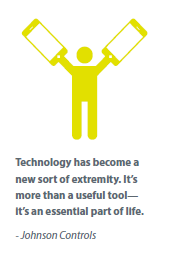 Let’s explore attracting and retaining talent with Well-Designed Workplaces because at the end of the day: IT’S MORE THAN JUST A PAYCHECK. Keeping workers satisfied through compensation is a high priority for organizations desiring to lower turnover rates, which can have negative effects on profitability and morale. But for many people, their job is more than pay and benefits. Where they work—and what their organization stands for—carries significant weight. What makes one organization more attractive than another to existing and prospective employees lies in its core values, which are expressed through its culture and brand. These values are weighed differently among individuals—and among generations.1
Let’s explore attracting and retaining talent with Well-Designed Workplaces because at the end of the day: IT’S MORE THAN JUST A PAYCHECK. Keeping workers satisfied through compensation is a high priority for organizations desiring to lower turnover rates, which can have negative effects on profitability and morale. But for many people, their job is more than pay and benefits. Where they work—and what their organization stands for—carries significant weight. What makes one organization more attractive than another to existing and prospective employees lies in its core values, which are expressed through its culture and brand. These values are weighed differently among individuals—and among generations.1
Today it’s more critical than ever for organizations to attract and retain top talent, and one component that can be used for recruiting, but is often overlooked, is the workplace. It’s more than just desks and chairs. Research shows that the work environment accounts for up to 25% of job satisfaction.2 Offering workers an attractive package that includes fair compensation is one way to help keep workers satisfied. The next step is for organizations to invest in a well-designed workplace that communicates its commitment to company values and brand.3
Attracting and Retaining Talent – NEW Talent
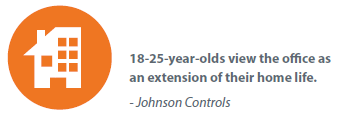 Because any work environment is likely to include members of four generations—Veterans, Baby Boomers, Generation X and the Millennials—it must accommodate the needs of a wide range of ages.4 In the last U.S. Census, the number of Millennials already surpassed the number of Baby Boomers by population.5 As the Boomers retire from the workforce, employees from Generation X and the Millennials are beginning to replace them. But the preferences and workstyles of the Millennial cohort have received much attention because of its size. Organizations that consider Millennial values will be the most successful.6
Because any work environment is likely to include members of four generations—Veterans, Baby Boomers, Generation X and the Millennials—it must accommodate the needs of a wide range of ages.4 In the last U.S. Census, the number of Millennials already surpassed the number of Baby Boomers by population.5 As the Boomers retire from the workforce, employees from Generation X and the Millennials are beginning to replace them. But the preferences and workstyles of the Millennial cohort have received much attention because of its size. Organizations that consider Millennial values will be the most successful.6
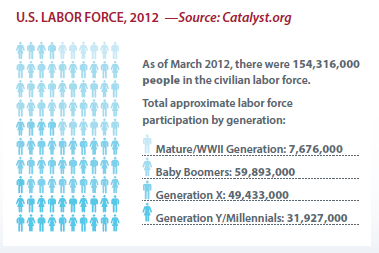 The Millennials are the generation born during or after the general introduction of digital technology, in the last decades of the 20th century. Digital Native expert Marc Prensky claims “they have spent their entire lives surrounded by and using computers, videogames, digital music players, video cams, cell phones and all the other toys and tools of the digital age.”7 They are tech-savvy and used to being connected from anywhere. They grew
The Millennials are the generation born during or after the general introduction of digital technology, in the last decades of the 20th century. Digital Native expert Marc Prensky claims “they have spent their entire lives surrounded by and using computers, videogames, digital music players, video cams, cell phones and all the other toys and tools of the digital age.”7 They are tech-savvy and used to being connected from anywhere. They grew
up with the Internet at their fingertips for entertainment and social activities, and now use it for business tasks. They are globally connected, flexible and collaborative because they have developed different communication styles due to advanced technologies such as social media. They are entering the workplace—and transforming it forever.8 Although they have many of the same needs as previous generations, Millennials are different in how they approach work, communicate and integrate technology into their daily lives. Research from Johnson Controls reveals significant findings that organizations should consider for attracting younger workers and accommodating their workplace preferences:
• They value sustainability.
• They’re flexible, mobile and unconventional.
• They prefer collaboration and interaction in the workplace.
• They demand to be connected 24/7.
• The workplace is a space they emotionally engage with—where they socialize.
• The workplace should support their health and well-being.
• The lines between their business and social worlds blur, and they often use the same devices for both.
• They want faster computers, more frequent software updates and higher Internet speeds.9
Organizations are challenged to commit to the values that workers—especially Millennials—are seeking, from corporate social responsibility (CSR), to work/life balance, distributed work, and health/wellness.10 And they are challenged to create work environments that attract younger employees without excluding the other generations.11
The role of Corportate Social Responsibility in Attracting and Retaining Talent
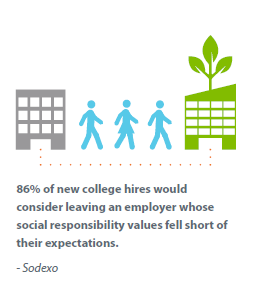 Both Generation X and the Millennials consider sustainability—an element of corporate social responsibility (CSR)—a core value.12 Sodexo suggests “initiatives that represent the passion and commitment of people who choose to live their values through their work” are related to job satisfaction, motivation and intent to remain with the organization. 13 And “organizations that inspire people to connect with their community and create meaningful, sustainable work environments are able to retain top talent, especially among the younger generations.” 14 Sustainability—which used to be a special feature in office environments—has now become standard, with organizations “incorporating recycled products (including buildings), locally sourced and sustainable materials, energy-efficient HVAC systems and better indoor air quality.”
Both Generation X and the Millennials consider sustainability—an element of corporate social responsibility (CSR)—a core value.12 Sodexo suggests “initiatives that represent the passion and commitment of people who choose to live their values through their work” are related to job satisfaction, motivation and intent to remain with the organization. 13 And “organizations that inspire people to connect with their community and create meaningful, sustainable work environments are able to retain top talent, especially among the younger generations.” 14 Sustainability—which used to be a special feature in office environments—has now become standard, with organizations “incorporating recycled products (including buildings), locally sourced and sustainable materials, energy-efficient HVAC systems and better indoor air quality.”
Making sustainability a design principle of the workplace helps turn the work environment into a tool for attracting and retaining top talent.15 The Millennials are known for having social consciences, which is why they’re drawn toward organizations that are committed to CSR. Sustainability is now a “must have” rather than
a “nice to have” when it comes to attraction and retention.16 And why not? Research shows that people who work in sustainably designed environments benefit from better health, decreased depression rates, improved sleep patterns and less eye strain.17 It’s a principle that works for all generations.environments benefit from better health, decreased depression rates, improved sleep patterns and less eye strain. 17 It’s a principle that works for all generations.
The role of Work/Life Blending in Attracting and Retaining Talent
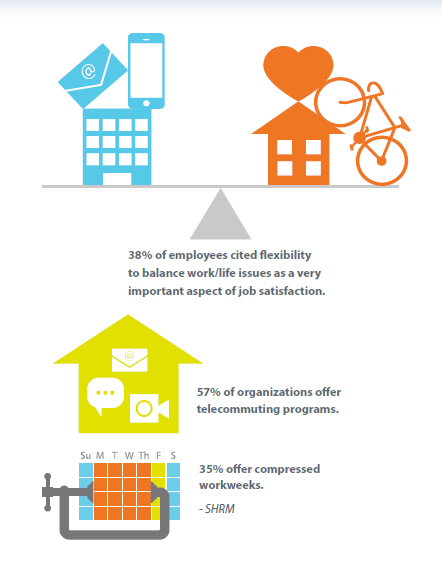 Organizations today are challenged with how to help employees blend their workload with their personal responsibilities, presenting creative benefits and perks to entice them. Technology has enabled work anywhere, which means people are accessing e-mails from mobile devices 24/7. To compensate, many companies are offering casual, flexible and fun policies—including unlimited vacation days, gym memberships, relaxed dress codes and childcare, to name a few.18 The Society for Human Resource Management (SHRM) suggests “workplace flexibility has a positive impact on employees’ worklife experiences. These low-cost initiatives can lead to increased employee job satisfaction, lower turnover and lower insurance costs.” 19 They can also encourage creativity and foster innovation by requiring people to get away from their routine by taking a sabbatical, for example. In a recent study, SHRM determined 53 percent of organizations offer flextime, in which employees can choose their work hours. Companies benefit from offering these options to workers by attracting and retaining people who can’t fit into a typical schedule working 9 to 5.20
Organizations today are challenged with how to help employees blend their workload with their personal responsibilities, presenting creative benefits and perks to entice them. Technology has enabled work anywhere, which means people are accessing e-mails from mobile devices 24/7. To compensate, many companies are offering casual, flexible and fun policies—including unlimited vacation days, gym memberships, relaxed dress codes and childcare, to name a few.18 The Society for Human Resource Management (SHRM) suggests “workplace flexibility has a positive impact on employees’ worklife experiences. These low-cost initiatives can lead to increased employee job satisfaction, lower turnover and lower insurance costs.” 19 They can also encourage creativity and foster innovation by requiring people to get away from their routine by taking a sabbatical, for example. In a recent study, SHRM determined 53 percent of organizations offer flextime, in which employees can choose their work hours. Companies benefit from offering these options to workers by attracting and retaining people who can’t fit into a typical schedule working 9 to 5.20
Not every perk or benefit fits for every organization, however. They shouldn’t be standard across organizations—it depends on what the workers value, and this can vary by generation. 21
The role of Distributed Work in Attracting and Retaining Talent
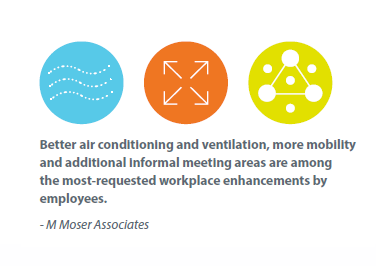 The outcome of the need for work/life balance and a flexible work schedule is often distributed work. People are working anywhere, anytime—from the office to third spaces, and from their kids’ athletic events to the airport gate. Microsoft Canada suggests “employers who can offer flexible workspaces to their employees are leading the pack in becoming employers of choice”— especially for the younger generation. 22 Work/life balance is key for Millennials to remain satisfied on the job, and organizations that facilitate mobility programs will be a magnet for this generation. 23
The outcome of the need for work/life balance and a flexible work schedule is often distributed work. People are working anywhere, anytime—from the office to third spaces, and from their kids’ athletic events to the airport gate. Microsoft Canada suggests “employers who can offer flexible workspaces to their employees are leading the pack in becoming employers of choice”— especially for the younger generation. 22 Work/life balance is key for Millennials to remain satisfied on the job, and organizations that facilitate mobility programs will be a magnet for this generation. 23
Because technology has “broadened the playing field for finding talent globally, ” organizations will need to make distributed work a priority and find ways to enable collaboration, both virtually and face-to-face. 24 With people distributed across the globe, virtual teams are relying more on collaborative technologies.25
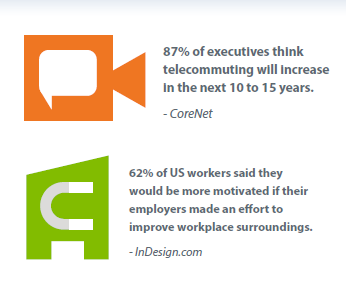 The emphasis on employee engagement as a foundation for innovation means companies will need to accommodate collaborative activities and foster a sense of community. Individual spaces will continue to shrink in both size and number. 26 Not just the Millennials, but also the elder generations have an increasing need for spaces that support teamwork. 27
The emphasis on employee engagement as a foundation for innovation means companies will need to accommodate collaborative activities and foster a sense of community. Individual spaces will continue to shrink in both size and number. 26 Not just the Millennials, but also the elder generations have an increasing need for spaces that support teamwork. 27
Even the meaning of individual space has changed: Technology is “so pervasive that a workstation is anywhere networks can be accessed wirelessly.” 28 Hoteling and shared spaces provide ways to accommodate heads-down work when needed to save space and allow group spaces to expand. Telecommuting programs are simple solutions for organizations to incorporate flextime into their corporate culture. It not only saves space and reduces costs; it can also increase worker productivity up to 20 percent. 29
The role of Health & Well Being in Attracting and Retaining Talent
In today’s challenging economic times and volatile business world, there are elements in the workplace that are just as important—and sometimes more valuable—than adequate pay and benefits. Sodexo research reveals that a psychologically safe and healthy workplace is essential for companies focused on human and organizational performance. 30 When the workplace is used as a strategic tool, organizations can create places where people can work and live better. They can adapt the workspaces to fit the worker instead of the other way around—addressing the needs of individuals. 31 Simply providing naturally lit environments with access to daylight and views can help people be more productive than in workspaces with artificial lighting. Enhancing indoor air quality can also improve employee health and satisfaction levels.32
Personal control is another way to enhance physical comfort and health. People feel better about their jobs when they can claim some control and ownership in the work they do as well as in the place in which they do it—even if that means simply adjusting the furniture and other tools in the workspace to better suit their individual needs. Granting individuals some control over the appearance and organization of their work area can improve a person’s perception of his or her work and the actual experience doing it. Even small adjustments can satisfy personal preferences related to aesthetics, workstyles and comfort, increasing worker satisfaction. 33
Beyond Employee Retention: Engagement
Once organizations have attracted top talent, what’s the secret to retaining high-performing workers? One way is through employee engagement. “Higher levels of engagement can be a result of reward and talent programs adopted by employers that creatively seek a balance between responding to employee needs and coping with cost pressures. Employees’ desire to preserve their jobs may have also contributed to higher engagement levels demonstrated by a willingness to go the extra mile, be resilient and embrace change.” 34
The strong correlation between engagement and retention is well understood. “Intent to stay,” or an employee’s stated desire to remain with his or her current employer, is a strong predictor of actual turnover. It is also an indication of how strongly committed an employee is to the employer’s success. Globally, 60 percent of all employees report that, given the choice, they plan on remaining with their current organization for the next 12 months. However, this number jumps to 81 percent among engaged employees but drops to 23 percent among the disengaged. 35
Design Implications for Attracting and Retaining Talent
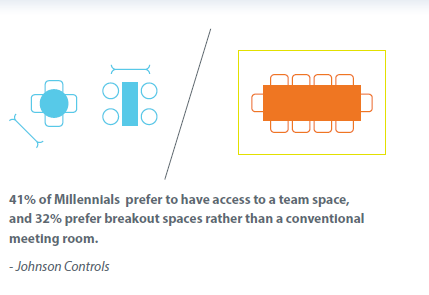 In a competitive race for talent, the workplace is a key component of the employment package organizations can offer. In fact, workplace effectiveness is “a strong factor in attraction and retention of talented people; ratings of a company’s attraction/retention capability are almost three times higher when workplace effectiveness rises above 80 percent.” 36 Companies with the highest WPI (workplace performance index) scores have close to perfect scores on valuing people, attracting/retaining talent and work/life balance. 37 It becomes a means for
In a competitive race for talent, the workplace is a key component of the employment package organizations can offer. In fact, workplace effectiveness is “a strong factor in attraction and retention of talented people; ratings of a company’s attraction/retention capability are almost three times higher when workplace effectiveness rises above 80 percent.” 36 Companies with the highest WPI (workplace performance index) scores have close to perfect scores on valuing people, attracting/retaining talent and work/life balance. 37 It becomes a means for
fostering long-term loyalty when the workplace both supports and rewards workers’ efforts. 38 Here are some ways to consider designing the workplace to incorporate the values of CSR, work/life balance, distributed work and health/well-being.
TO ATTRACT PROSPECTIVE EMPLOYEES
• Express culture and brand—from colors and furniture—to reflect the attitudes and values of the organization.
• Offer the latest technology tools to support collaboration, flexibility and mobility.
• Create dedicated third spaces for employees to collaborate in a space away from the main campus.
• Assign workspaces even for mobile employees to help foster social networks and interaction.
• Design work environments to support the work—group spaces for collaboration and privacy for heads-down work that requires concentration. 39
• Create a comfortable, residential, fun environment that feels like home, with amenities such as kitchens, pantries, living rooms, and family rooms. 40
• Incorporate sustainable design when planning a new facility and include sustainable practices in existing or new
• workplaces.
TO RETAIN EMPLOYEES
• Nurture social networks through events such as celebrations.
• Build relationships by supporting impromptu interactions in community spaces such as cafés, and along deliberate pathways throughout the facility.
• Offer a variety of workspaces with mobile furniture to support collaboration, mentoring and meetings.
• Provide spaces for independent, heads-down work.
• Offer mobility and flexibility programs, and the technology tools employees need to support their work.
• Update or refresh spaces frequently to help employees feel valued. 41
• Integrate technology to create smooth transitions between work and home.
• Solicit feedback, address concerns and ask for employee input about how to improve the workplace.
• Encourage consumerization, especially among Millennials, offering consumer-friendly IT solutions rather than
corporate.
• Allow workers to use their own technology, such as iPads and smartphones, to do their work. 42
What people really want at work is a comfortable, functional place where they can be themselves. The more employees can identify with their workspace, the more content and motivated they are at their jobs. 43
Organizations need to make sure work environments align with corporate culture and values as well as brand. Then, by understanding the attitudes and workstyles of four generations—with a focus on the Millennial cohort—they’ll be able to accommodate workers’ needs. Flexibility is key in creating inspiring workspaces that attract top talent and retain workers through an engaging employee experience.
For More Information:
 Steve Sable
Steve Sable
Hayworth – Dealer Sales Manager
1700 Market Street – Suite 600
Philadelphia, PA 19103
c: 215.397.5656
o:215.977.8607
www.haworth.com
REFERENCES
1. CoreNet 2012
2. CoreNet 2012
3. CoreNet 2012
4. CoreNet The Leader 2013
5. Catalyst.org
6. Johnson Controls, 2012
7. Prensky, Marc, 2001
8. Johnson Controls, 2012
9. Johnson Controls, 2012
10. CoreNet 2012
11. Johnson Controls, 2012
12. CoreNet, The Leader, Mar/Apr 2012
13. Sodexo 2013
14. Sodexo 2013
15. Sodexo 2013
16. Colliers International 2011
17. M Moser Associates, 2008
18. Malcolm, Hadley, USA Today, 2013
19. SHRM 2012
20. SHRM 2012
21. Malcolm, Hadley, USA Today, 2013
22. Microsoft Canada
23. CoreNet, The Leader, March/April 2012
24. Mitel 2012
25. Johnson Controls 2012
26. Sodexo 2013
27. Johnson Controls 2012
28. Sodexo 2013
29. M Moser Associates, 2011
30. Sodexo 2013
31. Sodexo 2013
32. M Moser Associates, 2008
33. Haworth Summary Paper, “The Importance of User Control,” Sept 2009
34. WorldatWork, 2010
35. Blessing White, 2013
36. HR.com, 2008
37. Gensler, Workplace Survey 2008
38. M Moser Associates, 2008
39. CoreNet, The Leader, 2013
40. Sodexo 2013
41. CoreNet, The Leader, 2013
42. Johnson Controls, 2012
43. InDesign.com, 2012
Ashley, Scott, “It’s Not a Workplace, It’s a Work Place,” CoreNet Global, The Leader, March-April 2013
Blessing White, “Employee Engagement Research Update,” January 2013
Catalyst.org, Generations in the Workplace in the United States & Canada, May 1, 2012. Retrieved May 2013.
Colliers International white paper, “Generation Y: Implications for Office Markets,” July 2011
CoreNet, The Leader, March/April 2012
CoreNet Global, The Leader, Member Viewpoints, May/June 2012
CoreNet, The Leader, 2013
Haworth, “Designing Across Generations,” Summary Paper, April 2009
Haworth, “The Importance of User Control,” Summary Paper, September 2009
HR.com, Gensler Survey Measures Connection Between Workplace Design and Business Performance, October 23, 2008. Retrieved May 2013.
InDesign.com, The Power of Office Design, June 20, 2012. Retrieved May 2013.
Johnson Controls, “Digital Natives: Born 2B Connected,” Global WorkPlace Innovation Report, 2012
M Moser Associates, “Sharpening the competitive edge in today’s talent wars,” 2011
M Moser Associates, “The business case for sustainable workspace design,” 2008
Malcolm, Hadley, “Pets at work, time off: Employers add perks,” USA Today, April 29, 2013
Microsoft Canada, Flexible Workspaces Survey, 2012
Mitel Networks corporate white paper, “Work 3.0: The Next Generation Model for Smarter Business,” July 2012
Prensky, Marc, “Digital Natives, Digital Immigrants,” On the Horizon, MCB University Press, Vol. 9 No. 5, October 2001
Society for Human Resources Management, “2011 Employee Job Satisfaction and Engagement: Gratification and Commitment at Work in a Sluggish Economy”
Society for Human Resources Management, “2012 Employee Benefits: The Employee Benefits Landscape in a Recovering Economy”
Sodexo 2013 Workplace Trends Report World at Work, June 30, 2010


